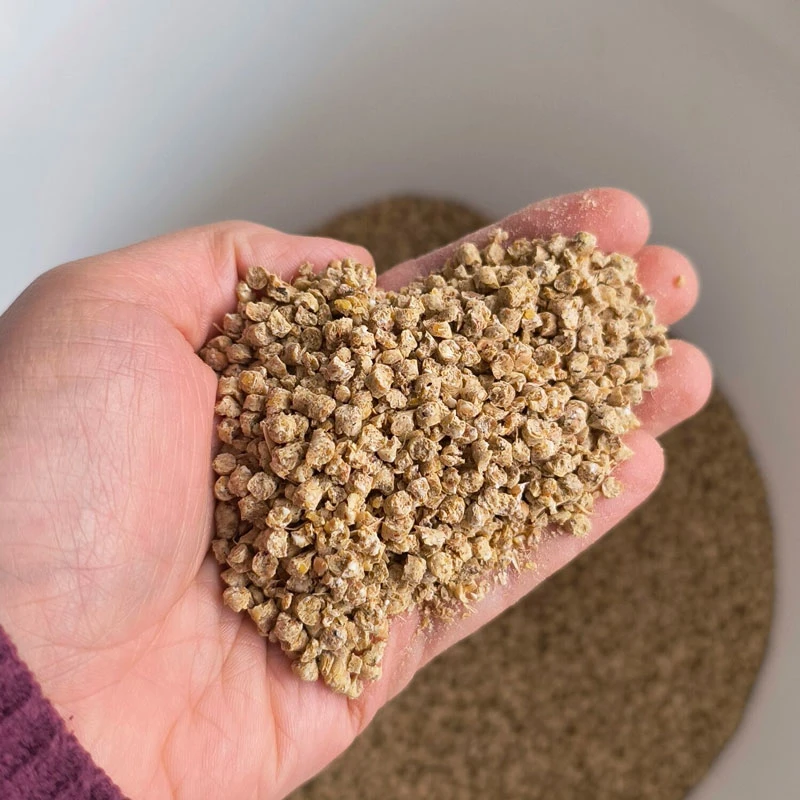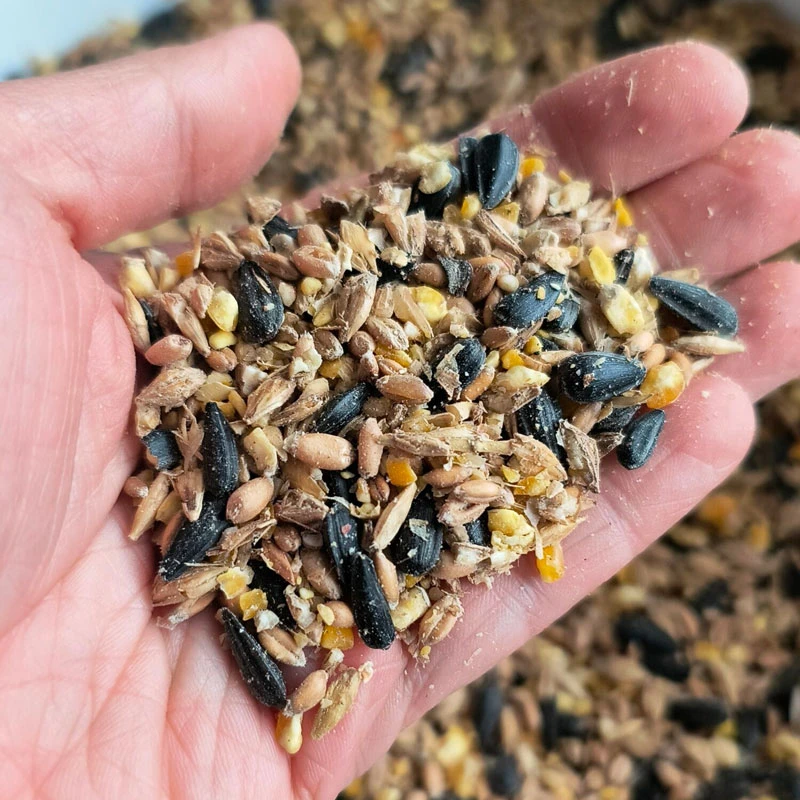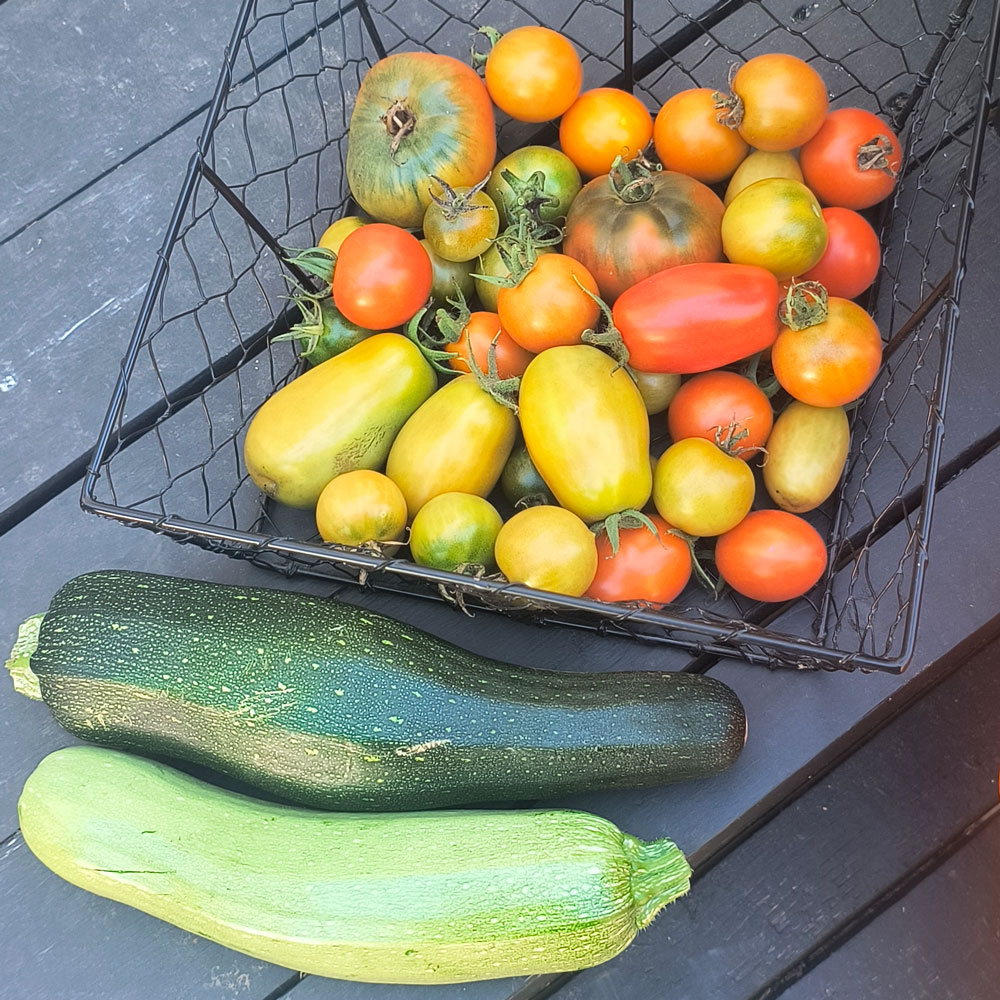What Do Our Chickens Eat?
I’m often asked what we feed our chickens here at Roots, Roost & Rafter, so here’s the scoop!
(Quick note: this is what we feed our chickens. Our geese have their own menu and nutritional needs.)
The feed you see here makes up the bulk of our flock’s diet. It’s Chicken Grower Feed from Sollio, which we buy at Scotian Gold in Coldbrook, NS.
Everyone eight weeks or older gets this feed. Chicks get unmedicated Chick Starter instead.

Wait, You Feed Grower Feed to Everyone?
Yup, we sure do! Since our flocks include roosters (and also hens/pullets in various stages), we have to meet their needs along with the laying hens. Layer feed is meant for hens that are actively laying eggs. It should not be fed to birds that aren’t laying.
Layer feed usually contains around 4% calcium, while non-laying birds only need about 1%.
That makes layer feed a bad choice for:
– Young pullets who aren’t laying yet.
– Roosters and cockerels of any age.
– Hens taking a break from laying (during molt or winter).
– Senior hens who have stopped laying altogether.
Feeding layer feed short term to pullets or temporarily resting hens probably won’t hurt them – but feeding it long term to roosters or retired hens can cause serious problems.
Their bodies don’t have a way to use all that extra calcium, so their kidneys have to work overtime to remove it. Over time, this can lead to kidney dysfunction or failure. Kidney dysfunction/failure, in turn, can cause visceral gout and sometimes also articular gout – painful uric acid deposits in organs (visceral gout) or joints (articular gout).
If you want to dig deeper, the folks at PoultryDVM have excellent resources on this.
Why We Chose This Feed
Feed options are rather limited in our area and this grower feed comes as close to meeting the needs of everyone as we can get with our options. It’s too low in calcium for our actively laying hens but we supplement them to make up for it. It’s, unfortunately, a bit high in protein for the roosters when they aren’t breeding as well. There’s not much I can do about that though without diluting the feed to lower the protein to the detriment of the hens who need more protein than them.
There isn’t a chicken feed, to my knowledge, that has the 12% protein a fully grown rooster needs in maintenance (when they aren’t breeding). They all have quite a bit more than that. There aren’t enough people who keep roosters long term for feed companies to bother with a specific rooster formulation so the boys kind of have to make due. Most roosters end up as food at a young age and, the ones who don’t, are often fed layer pellets along with the hens they’ve been kept to protect.
Grower feed checks all the other boxes for the boys besides the protein content though. Actually, breeding roosters need a bit more protein than non-breeding ones so, during the hatching season, the grower feed will check all of the boxes for the boys. It’s just about ideal for them then, it’s just the off season that it’s a bit too high
How the Laying Hens Get Their Calcium
Our hens get oyster shell grit available free-choice in each coop. They eat it when they need extra calcium, and stop when they don’t – nature’s own system of self-regulation.
Roosters generally ignore it, though sometimes they’ll pretend to eat a piece or two just to encourage a hen. (Classic rooster move.) To make sure the boys can’t get too much even if they do decide to try and eat it, I serve oyster shell in chick feeders – their big wattles and combs make it tricky (if not impossible) to eat out of these feeders.

Treats, Training, and Seasonal Snacks
Each flock gets a small amount of scratch grains mixed with black oil sunflower seeds in the morning and evening – a treat, not a meal.
This mix also doubles as our “hawk drill” tool. If I shake the scratch jar and yell “HAWK!”, every bird sprints back to the safety of their run. Whether or not there’s an actual hawk, well, they don’t take chances.
When the weather’s nice, the chickens forage for plants and insects in their pastures. During the gardening season, I even dedicate a section of the garden just for them.
Their favorites? Zucchini, winter squash, cucumbers, kale, and tomatoes. They also get apples, blueberries, and blackberries from our property — and all the garden weeds and pests they can handle.
If we have any pest problems in the garden (ahem, potato beetles, I’m talking about you), I collect up the bugs and feed them to the chickens as well. They can eradicate a potato beetle infestation FAST so this is a win for everyone involved – except the potato beetles, I suppose.
Winter Feeding
In winter, foraging time is over, so I get creative.
I’ve experimented with growing fodder (sprouted grains) indoors, though mold issues made that tricky last year. This season, I’ve got new ideas to try. I also feed produce on sale, kitchen scraps (fruit and vegetable peelings/cut-offs), and occasionally cooked eggs from our extra stock.
Yes, chickens love eggs! They’re packed with nutrition and totally natural as part of their diet. Remember, that’s a chick’s first meal before hatching.
I’ve been on the LOOP program waitlist for a couple of years now – it redirects unsold grocery produce to farms – and I’m hopeful we’ll get accepted soon. The chickens would definitely appreciate it during the long, snack-less months.
Do We Feed Organic?
I’d love to say yes but, the truth is, we’re not fully organic. Anything I grow or forage for the chickens is organic, we use no pesticides and only organic fertilizers, but the commercial feed is not.
Why? Mainly cost and availability. Organic feed costs more than twice as much, and sometimes it’s out of stock for months. I’m not even sure if the local farm store carries a grower version of the organic feed either. To make the switch, we’d have to charge around $10 per dozen eggs instead of $6 (just to break even, not to make a profit) and that’s a big jump for local customers – even if the eggs are organic. So, for consistency of feed and to keep the cost of the eggs we sell down, we don’t do organic feed but everything else they consume is organically grown.
Even so, I’d argue our eggs are still far superior to anything you’ll find in a store. Our hens breathe fresh air, feel the sun on their feathers, and have room to roam – something most commercial hens will, sadly, never know.
Any Other Questions?
Hopefully that answers your curiosity about what our chickens eat!
If not, you can always ask – I’m happy to talk chicken feed anytime.


About the Author
Hey! I’m Krystal - one of those quirky, super-introverted types in real danger of becoming a hermit. You know the kind. I usually leave the mountain once a week for provisions, load up on chicken feed, shavings, groceries, and whatever lumber I’ve convinced myself I need, then hurry back home where it’s quiet and a lot less people-y.
Turning our little property into a thriving homestead has become my passion (and maybe my obsession). If you happen to stop by, you’ll almost always find me outside doing something - building a new coop in the chicken village, tackling a half-finished project, tending the garden, doing chicken chores, or wrangling birds. On the rare chance you catch me indoors, I’m probably in the kitchen or knee-deep in sketches and plans for whatever I’ve decided to do next.
If you like what you see here, come hang out with me on Facebook and Instagram for more homestead stories, flock updates, and a good dose of cozy chaos.
Thanks for stopping by!